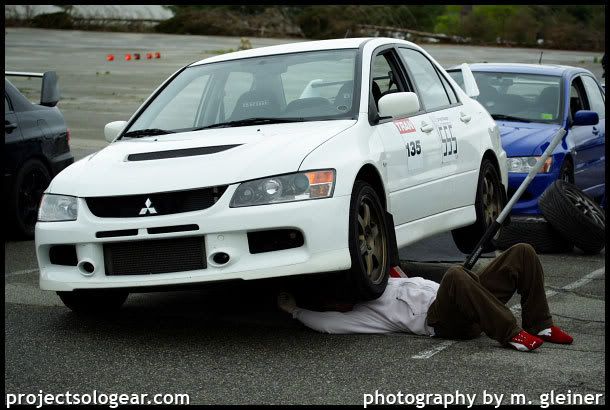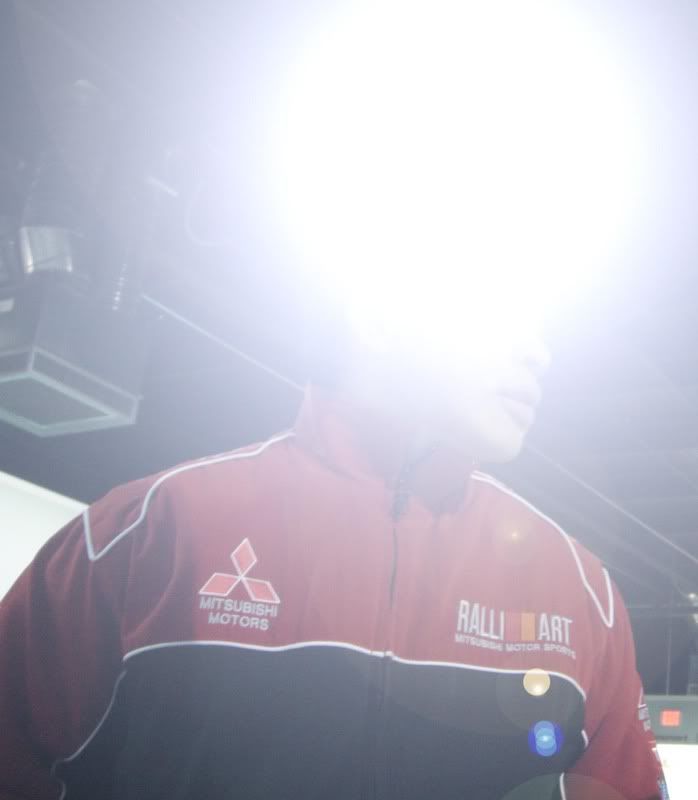
Friday, August 3, 2007
It's All Mental

Tuesday, May 22, 2007
As Stiff As It Gets
 The May 20th autocross was the first one with the new suspension setup and alignment. I had my car cornerbalanced and aligned at Bishop Motorsports with a perfect cross-weight of 50/50 and -2.5 camber front, -1.5 camber rear. After keeping tire pressures at a constant 40 psi, the first three runs were done under 5 clicks from full stiff both front and rear. The car handled like a dream, the back and forth transitions were on key and the high speed damping proved its merit as turn-in from sweepers proved to be on point. I did not feel any body-roll so the rear swaybar definately helped in conjunction with the dampers. I definately was overdriving the car a bit because I would lose valuable time sliding around on my tires but after realizing this I must make an attempt to be more smooth so that I can harness the tire's maximum traction to become faster. On one of my runs my bypass/diverter valve (aka blow off valve) blew off on one of my cleaniest runs of the day, it was definately dissapointing but this stuff happens. Not only that but I found out that I was boosting only 19 psi and decreased power (was tuned at 21psi) on my way back home. I knew the car felt a bit sluggish coming off the line, but I was more focused trying not to hit cones than on my manual boost gauge. I ordered a Tactrix OBDII cable which would allow me to log the ECU and other parameters with my laptop. With this data I will be able to set the manual boost controller to the correct setting and output the correct boost for my application. Later on as the day progressed tire pressures were bumped up to 42 psi and I was tempted to stiffen up the dampers a bit more 'just for kicks' so I added 2 clicks in the front and 1 click in the rear from full stiff, this proved to be a pretty decent setup if I was running R-compounds but was a bit too stiff for the street tire. I think that 4 clicks in the front and 3 clicks in the rear would be the perfect for street tire and will try this setting next time. This has been my second autocross of the year and I feel that with a couple more I will become more confident on driving within the limits of the tires with the Ohlin DFVs. I'm picking up some 17x9 wheels with R-compounds that I found which were a good deal off the Evo forums so stay tuned as I will be getting my fenders rolled and running Kuhmo 700 Victoracers! I look forward to the next one. See you all out there!
The May 20th autocross was the first one with the new suspension setup and alignment. I had my car cornerbalanced and aligned at Bishop Motorsports with a perfect cross-weight of 50/50 and -2.5 camber front, -1.5 camber rear. After keeping tire pressures at a constant 40 psi, the first three runs were done under 5 clicks from full stiff both front and rear. The car handled like a dream, the back and forth transitions were on key and the high speed damping proved its merit as turn-in from sweepers proved to be on point. I did not feel any body-roll so the rear swaybar definately helped in conjunction with the dampers. I definately was overdriving the car a bit because I would lose valuable time sliding around on my tires but after realizing this I must make an attempt to be more smooth so that I can harness the tire's maximum traction to become faster. On one of my runs my bypass/diverter valve (aka blow off valve) blew off on one of my cleaniest runs of the day, it was definately dissapointing but this stuff happens. Not only that but I found out that I was boosting only 19 psi and decreased power (was tuned at 21psi) on my way back home. I knew the car felt a bit sluggish coming off the line, but I was more focused trying not to hit cones than on my manual boost gauge. I ordered a Tactrix OBDII cable which would allow me to log the ECU and other parameters with my laptop. With this data I will be able to set the manual boost controller to the correct setting and output the correct boost for my application. Later on as the day progressed tire pressures were bumped up to 42 psi and I was tempted to stiffen up the dampers a bit more 'just for kicks' so I added 2 clicks in the front and 1 click in the rear from full stiff, this proved to be a pretty decent setup if I was running R-compounds but was a bit too stiff for the street tire. I think that 4 clicks in the front and 3 clicks in the rear would be the perfect for street tire and will try this setting next time. This has been my second autocross of the year and I feel that with a couple more I will become more confident on driving within the limits of the tires with the Ohlin DFVs. I'm picking up some 17x9 wheels with R-compounds that I found which were a good deal off the Evo forums so stay tuned as I will be getting my fenders rolled and running Kuhmo 700 Victoracers! I look forward to the next one. See you all out there!
Sunday, April 29, 2007
New Year?? New Suspension!!
I've decided to run a new suspension setup this year because I feel that with the increase in power I have to have balance that out with a better suspension setup to harness it. I've decided to go with Work's Stage III suspension package which is composed of Ohlins DFV coilovers with 10k/10k spring rates and a 24mm adjustible rear sway bar. The reason why I chose this setup is because Ohlins is well known in the suspension tuning field and Works adds that extra touch. This setup should yield better results than the stock suspension. Not to mention the spring rates aren't too harsh for a daily driver. These dampers can also be re-valved for higher spring rates in the future once I have more experience on the track. My primary concern for the Evo will be for road courses first and autocross second. I feel that the suspension should give me some additional cornering force but without sticky R-compounds I won't be able to use the setup optimally. It will be a learning process to learn how to adjust the settings along with the rear swaybar and tire pressures. I will be keeping a log of the temperatures and each of the settings for future reference.
Saturday, April 28, 2007
Dusting Out the Old Cobwebs (4/28/07 AutoX thoughts)
Tuesday, April 24, 2007
An Evolution of Epic Proportions

UPDATED: 8/4/07
My Evo has undergone a lot of changes since I first got her, I wasn't planning on modifying the car but I just had the urge to push the envelope and see what this car can do... this list will be updated periodically... stay tuned as more items get added!
Exterior:
JDM IX REAR BUMPER
JDM IX HEADLIGHTS
JDM IX TAIL LIGHTS
S2K SHORT ANTENNA
3M CLEAR FILM
RALLYARMOR MUDFLAPS
DEBADGED 'LANCER EVOLUTION' SYMBOLS FROM TRUNK
Interior:
BRIDE ZETA III RACING SEATS WITH BRIDE FG RAILS
DEFI D BOOST GAUGE
OEM CENTER RELOCATION KIT
GRUPPE-S 3 GAUGE CENTER COVER
DEFI BF IMPERIAL OIL PRESSURE GAUGE
DEFI BF IMPERIAL OIL TEMPERATURE GAUGE
DEFI BF IMPERIAL WATER TEMPATURE GAUGE
DEFI V2 LINK
GTSPEC OIL ADAPTER
GTSPEC WATER HOSE ADAPTER
COMPUSTAR PRO P2W9000FMR ALARM
Engine:
RALLIART COOLING PLATE
KOYO RACE RADIATOR
RALLIART 1.3BAR RADIATOR CAP
WORKS DROP IN INTAKE W/ CLEANING KIT
HALLMAN PRO MBC
AMS LICP
255 WALBRO FUEL PUMP
GREDDY 3'' TITANIUM CATBACK EXHAUST
WORKS 3'' HIGH FLOW CAT
WORKS 3'' COATED DOWNPIPE
DYNOFLASH CUSTOM DYNO TUNE @21 PSI
Suspension:
EVO8 RIMS/ SNOW TIRES
OHLINS DFVS 10K/10K VALVED COILOVERS
WORKS ADJUSTIBLE 24MM REAR SWAY BAR
VOLKS TE37 17x8.0 5x114.3 +33 Offset
FALKEN AZENIS RT-615 TIRES 235/45/17 (Daily driving)
RAYS-ENGINEERING LIGHTWEIGHT LUGNUTS
POWERSLOT SLOTTED FRONT ROTORS
OEM AIR BRAKE GUIDES
17x9 BLACK RACING PRO N1 (BRONZE) W/ 255/45/17 KUHMO VICTORACER V700
Sunday, April 22, 2007
First Autox of the '07 Season

Wednesday, April 18, 2007
Some Cornering Theory

The Racing Line
It is a common myth that adopting "the classic racing line" will get you around the track in the quickest possible time! Although most of us on the road can quite easily demonstrate the racing line, unless you have experience of track driving, few will totally understand the varying situations which the racing line can be applied and adapted.
The Classic Racing Line:- The typical racing line which most can relate to is the classic geometric line, where the apex is somewhere in the exact centre of the corner. This exact line is what you would draw with a compass, using every inch from the outside edge to inside edge and back out to the outside again in a constant radius. This line is known to be "the fastest" way around a corner. However, this is only in isolation to all other factors. Although it may be the fastest way around a corner, it may not make up the best line when considering the overal package of getting the fastest possible lap time when you have to consider all other parts of the track.
The main reason why the geometric line is not always the fastest is simply because there is normally something following the corner which is more important (i.e the long straight!). If you have ever competed with other cars on a race track you know that the best place to overtake is on the straight as opposed to a corner. Also on straights there is more time to be gained than on corners.
The classic racing line therefore, is best suited when there is little opportunity after the corner to use overall speed to be faster than another car (i.e another corner quickly approacing after exiting)
The Ideal Racing Line:- The basic theory behind the ideal racing line is that it allows the driver to get on the power at an earlier stage than would be possible with the classic racing line. However, the ideal racing line is slower than the classic racing line. The reason for this is that to allow for an earlier application on the power (which will benefit you, not immediately but on the long straight) you must make the turn in later and go deeper. To make this earlier power application possible, you must be slightly slower into the corner due to the tight initial radius which makes the earlier power application possible.
Typically the power application stage on the classic racing line is when you have hit the apex and are approaching the outside edge of the track. With the ideal racing line you apply the power just slightly after you have hit the inside of the corner - way before you return to the outside of the track.
To explain these two lines, and how they work in a race, imagine two cars of equal power are racing each other. Car A is taking the classic line and Car B is taking the ideal line, and the corner in question leads to a long straight. On entry Car A will move ahead of Car B as he wishes to carry more speed through the corner, Car B goes slightly deeper into the corner, to set up an earlier power application, while Car A is increasing the gap. Car A hits the inside corner of the track and goes wide to the outside of the track. At the same time Car B is already on the power much earlier in the corner. Car A cannot yet accelerate as it is still riding out the corner. Because Car B was on the power earlier he carries more speed down the straight, and before too long has not only caught up Car A, but due to the fact that he has been on the power longer slips easily past him. The ideal line is not only better in this situation because you get on the power earlier, but also because you spend more time braking and accelerating as opposed to simply cornering.
The Classic Racing Line:- Early turn in, early apex.
+ Good if you need to get around a corner as quickly as possible, as there is no long straight ahead to make an overtake.
- Poor if you are entering a long straight, where early application of power will not be possible.
The Ideal Racing Line - Late turn in, late apex.
+ Ideal if you are exiting out a corner to a long straight, where the late apex, early power will reward.
- Poor if you need ultimate speed through a corner, and there is no opportunity to recoup and reduce lap time via a long straight.
(exerpt from: http://www.driversdomainuk.com/motorsport/racing_line.php)

